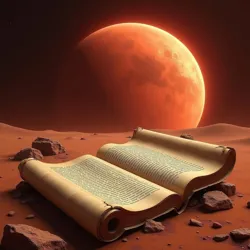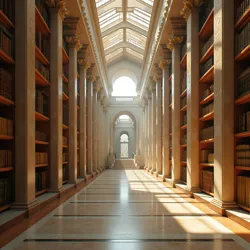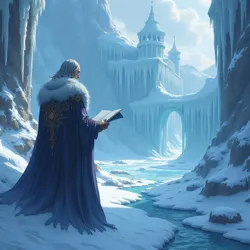Literary Works of the Martian Nations, listing representative works and replete with famous and memorable quotations

A representation of Martian literary mediums, blending ancient forms with recovered technology.
Foundation of Martian identity and shared history
Memory of Earth, adaptation to Mars, technological loss, resource scarcity, dual moons cycles
Epics, Covenants, Ice Ballads, Dome Sonnets, Data-chants
The literary traditions of the Martian nations represent a vibrant tapestry woven from threads of loss, adaptation, and the enduring human spirit. Born from the cataclysm of the Great Collapse and the subsequent isolation on Mars, these literary forms serve as a crucial repository of Martian history, philosophy, and cultural identity. Unlike Earth's literary heritage, which sprawls across millennia of unbroken technological and cultural progression, Martian literature emerged from a crucible of technological regression and environmental adaptation. This unique genesis has resulted in a body of work deeply concerned with themes of survival, the fragile Martian ecosystem, the haunting memory of a lost Earth, and the complex relationship between humanity and technology in a post-collapse world. The diverse nations that now populate Mars, from the technologically adept Meridian Confederacy to the ice-dwelling Frost Kingdoms, each possess distinct literary styles and narratives, reflecting their unique environments, societal structures, and historical experiences. Yet, a common thread of Martian identity binds these disparate traditions, forged in the shared crucible of their planetary exile and the ongoing struggle to build a new civilization under the ruddy sky of Mars.
Literary Heritage of the Meridian Confederacy
The Covenants of Atmosphere and Water
The Meridian Confederacy, with its origins in the terraforming engineer guilds of the initial Martian colonization, possesses a literary tradition deeply intertwined with its technological and environmental ethos. Central to their literary canon are the Covenants of Atmosphere and Water, a collection of foundational texts that are both legal codes and epic poems. These covenants, traditionally attributed to the mythical figure of "Khrono Hydrator," the supposed first Grand Artificer of Atmosphere, outline the principles of resource management, atmospheric stewardship, and the delicate balance necessary for survival within the enclosed environments of Meridian cities like New Alexandria. They are not merely dry technical manuals, but rather richly allegorical works that imbue the scientific principles of atmospheric maintenance and water reclamation with a quasi-religious significance. Passages from the First Covenant are often recited during civic ceremonies and atmospheric equinox festivals:
“Let the breath of Mars be as a sacred trust, each molecule accounted, each cycle revered. For the dome is our lung, and the engine our heart, and vigilance the very pulse of our being. Waste not a droplet, nor vent a sigh untamed, for in scarcity lies strength, and in balance, survival’s flame.”
These lines exemplify the Meridian literary style: didactic yet poetic, practical yet imbued with a sense of profound responsibility. The Covenants are not static texts, but living documents that are constantly reinterpreted and expanded upon by the Guild of Atmospheric Sciences and the Aquifer Technocracy, the two dominant societal organizations within the Confederacy. Scholarly commentaries and annotations on the Covenants form a significant subgenre of Meridian literature, reflecting the Confederacy's emphasis on continuous learning and adaptation.
Dome Sonnets and City Laments
Beyond the foundational Covenants, Meridian literature also encompasses more personal and reflective forms. The Dome Sonnets are a popular poetic form, particularly within the enclosed cities of the Confederacy. These sonnets, typically fourteen lines following intricate rhyming schemes in Ares Creole, often explore themes of urban life within the domes, the longing for open skies (a concept largely abstract to most dome-born citizens), and the complex psychological landscape of living in a technologically maintained environment. A celebrated example is "Nocturne in Ferroglass," by the poet-engineer Lyra Caelestis:
“The ferroglass sighs, a breath of recycled air, Below, the city hums, a phosphor-pale domain. Above, the void stares, a silent, cold despair, Reflecting back the glow, a manufactured rain. We walk these metal veins, beneath a false-starred night, And dream of breezes wild, and skies of azure hue. Yet in this crafted world, we find a tempered light, A fragile haven built, beneath the crimson view. For even in this cage, where artifice takes hold, The human heart still beats, a story to unfold. And though the Earth is lost, and skies are not our own, Within these domes we build, a future to be known. So let the sonnet rise, a dome-born melody, To celebrate the life, in our metallic sea.”
The City Laments represent another significant form of Meridian poetry. These longer, narrative poems often recount historical events, particularly disasters or periods of crisis within the dome cities. They serve as both historical records and cautionary tales, reminding citizens of the fragility of their artificial environment and the constant need for vigilance. "The Ballad of the Great Seal Breach," for instance, details the catastrophic failure of a dome seal in Old Meridian City centuries ago, a tragedy that serves as a constant reminder of the potential consequences of technological hubris or negligence.
 The Grand Library of Alexandria Nova, a repository of Meridian literary works and technological treatises.
The Grand Library of Alexandria Nova, a repository of Meridian literary works and technological treatises.Data-chants and Algorithmic Verse
Reflecting the Meridian Confederacy's technological orientation, a unique literary form known as Data-chants has emerged. These are not traditional written texts, but rather complex sequences of encoded data designed to be "read" or experienced through specialized sensory interfaces. Data-chants can take various forms, from immersive virtual realities to complex sonic landscapes, and are often used to transmit cultural narratives, historical accounts, and even philosophical concepts. They represent a fusion of art and technology, and are seen as a uniquely Martian contribution to literary expression. The Algorithmic Verse is a related, though distinct, form, involving poetry generated by sophisticated computer programs. While some traditionalists view algorithmic verse with suspicion, considering it lacking in true human emotion, it has gained increasing popularity, particularly among younger generations fascinated by the potential of artificial creativity. Critics and proponents alike actively debate the place of algorithmic verse within the broader canon of Meridian literature, raising questions about authorship, originality, and the very definition of art in a technologically advanced society.
Literary Expressions of the Frost Kingdoms
Ice Ballads and Rime Sagas
In stark contrast to the technologically focused literature of the Meridian Confederacy, the Frost Kingdoms have cultivated a rich oral tradition centered around Ice Ballads and Rime Sagas. These narrative forms, passed down through generations of storytellers and skalds, reflect the harsh beauty of the polar environment and the resilient spirit of the Frostfolk. Ice Ballads are typically shorter, lyrical poems that recount personal experiences, often focusing on themes of survival, love, loss, and the ever-present dangers of the ice wilderness. Rime Sagas, on the other hand, are epic in scope, detailing the legendary histories of the Rime Dynasties, the heroic deeds of ice-lords, and the foundational myths of the Frost Kingdoms. They are often performed during winter festivals and clan gatherings, serving to reinforce communal identity and transmit cultural values. A fragment from the Saga of the Frost Giants, a foundational text for many Frost Kingdom clans, illustrates the saga style:
"From the glacier's heart, they were hewn, Sons of the ice, beneath two moons. With breath of frost, and will of stone, They claimed the North, and made it their own. Through blizzards blind, and winters deep, Their fires burned, while others sleep. The Rime Lords rose, in ages past, Their legacy etched, to forever last."
The language of the Ice Ballads and Rime Sagas, often referred to as "Glacier Tongue," is characterized by its stark imagery, rhythmic cadence, and evocative descriptions of the icy landscape. Metaphors drawn from the frozen world – glaciers, blizzards, ice caves, auroras – permeate these works, shaping both their aesthetic and thematic concerns.
Whisper-Songs and Aurora Glyphs
Beyond the grand narratives of the sagas and ballads, the Frost Kingdoms also possess more intimate and esoteric literary forms. Whisper-Songs are short, often improvised poems, traditionally sung in low voices during the long polar nights. They are deeply personal and introspective, exploring the inner emotional landscape of the singer, and are often used as a form of meditation or emotional release. The ephemeral nature of these songs, often lost to memory once sung, reflects the Frostfolk's acceptance of impermanence and the cyclical nature of life in their harsh environment. Aurora Glyphs represent a more visually oriented form of Frost Kingdom literature. These are not written texts in the conventional sense, but rather intricate patterns of light and color projected onto ice walls or snowfields using sophisticated aurora-manipulation technology. These glyphs can convey complex narratives, philosophical concepts, or even emotional states, and are often used for ceremonial purposes or to mark important locations within ice cities. The fleeting and ethereal nature of the Aurora Glyphs further emphasizes the Frost Kingdom's aesthetic sensibility, one that values beauty in impermanence and meaning in subtle, fleeting expressions.
 A Skald of the Frost Kingdoms, recounting tales of ice and resilience within the ice-carved city of Glacierhearth.
A Skald of the Frost Kingdoms, recounting tales of ice and resilience within the ice-carved city of Glacierhearth.Runecraft and Ice Script
While oral tradition remains dominant, the Frost Kingdoms also possess forms of written literature, albeit less prevalent than in the Meridian Confederacy. Runecraft involves the carving of symbolic runes into ice, bone, or durable synth-ice materials. These runes, drawn from an ancient Frost Kingdom script, can represent words, concepts, or even entire narratives. Runecraft is often used for practical purposes, such as marking territory, recording agreements, or creating durable records in the harsh polar environment. Ice Script, a more recent development, involves the use of thermo-sensitive inks on specially treated ice-paper. This allows for more complex and detailed written texts, though the fragility of ice-paper and the specialized conditions required for its preservation limit its widespread use. Ice Script is primarily employed for scholarly works, personal journals, and official records within the Rime Dynasties. The development of Ice Script represents a fascinating intersection of traditional Frost Kingdom culture and recovered pre-Collapse technologies, demonstrating the ongoing evolution of their literary forms.
Common Themes in Martian Literature
The Echo of Earth and the Trauma of the Blight
Across all Martian nations, the memory of Earth and the Great Blight that led to humanity's exodus remains a powerful and pervasive theme in literature. Earth is often depicted as a lost paradise, a mythical Eden from which humanity was tragically expelled. However, this idealized vision is often tempered by the shadow of the Blight, a catastrophe shrouded in mystery and fear. Martian literature grapples with the trauma of this loss, exploring themes of displacement, exile, and the enduring psychological scars of a planetary catastrophe. Poems like "Elegy for Azure Skies" (Meridian Confederacy) and sagas like "The Lament of Old Terra" (Frost Kingdoms) express a profound sense of longing for a home that is both remembered and irretrievably lost. The nature of the Blight itself is a recurring motif, with various literary works offering different interpretations – environmental collapse, runaway pandemics, technological warfare, or even divine retribution. This ambiguity reflects the historical uncertainty surrounding the Blight and its enduring impact on Martian collective consciousness. As the Meridian poet, Lysandra Chronos, wrote in her cycle "Fragments of a Shattered Past":
"We are children of the dust, born beneath a borrowed sky, Haunted by the ghost of azure, where our ancestors did fly. What poisoned Eden's garden, what fire consumed the green? A whisper in the data-winds, a nightmare in a dream."
Adaptation, Resilience, and the Martian Landscape
Martian literature is deeply rooted in the unique environment of Mars and the ongoing process of human adaptation to this alien world. The themes of resilience, resourcefulness, and the complex relationship between humanity and the Martian landscape are central to many works. From the Covenants emphasis on environmental stewardship to the Ice Ballads' celebration of Frostfolk hardiness, Martian literature reflects a profound awareness of the challenges and opportunities presented by their adopted planet. The stark beauty of the Martian deserts, the towering volcanoes, the vast canyons, and the ethereal dance of the two moons all find their way into Martian literary descriptions, shaping the aesthetic and symbolic landscape of their narratives. The Calendar of Two Moons, with its unique temporal rhythms, also influences literary structures and themes, with cyclical patterns and lunar symbolism frequently appearing in Martian poetry and prose. The Martian philosopher-poet, Kryos of Glacierhearth, in his treatise "The Frozen Hearth," wrote:
"Mars is not Earth, nor should we seek to remake it in that image. It is a world of its own, a crucible of adaptation, a teacher of resilience. Our literature must sing not of a lost paradise, but of the hard-won beauty of this red domain, the strength forged in scarcity, the wisdom learned from the ice and dust."
Technology, Loss, and the Search for Lost Knowledge
The ambiguous relationship with technology is another defining characteristic of Martian literature. While the Meridian Confederacy retains a degree of technological sophistication and celebrates engineering prowess, the memory of the Great Collapse and the loss of advanced pre-Collapse technologies casts a long shadow. Martian literature often explores the double-edged sword of technology, its potential for both salvation and destruction. There is a recurring motif of lost knowledge, of fragmented data and half-understood technologies from the Earth era, which fuels a sense of both yearning and caution. The Universities of Olympus and the Phobos Observatory, centers of learning and recovery efforts, are often depicted in literature as both beacons of hope and reminders of the vastness of what has been lost. The Terran Restoration Movement, with its quasi-religious devotion to Earth and its pursuit of lost spaceflight technology, is also a frequent subject of literary exploration, often portrayed with a mixture of hope, skepticism, and cautionary warnings against repeating the mistakes of the past. The Meridian play The Engineer's Lament, a popular dramatic work, features the poignant line:
"We stand upon the shoulders of giants, yet we grasp only at shadows. We wield tools we barely understand, haunted by the ghosts of their creators. Have we inherited progress, or merely the ruins of a forgotten ambition?"
Notable Martian Authors and Works
This table provides a glimpse into the diverse landscape of Martian literature, highlighting key authors, their representative works, and memorable quotations that encapsulate the essence of their literary contributions. These figures, though fictional, represent the kinds of voices and perspectives that would likely emerge in a post-collapse Martian civilization, grappling with the unique challenges and opportunities of their adopted world.
The Enduring Influence of Martian Literature
Martian literature is not merely a collection of texts; it is a living, breathing force that shapes Martian culture, identity, and worldview. The Covenants of Atmosphere and Water are not just legal documents; they are foundational myths that inform Meridian societal values and environmental ethics. The Ice Ballads and Rime Sagas are not just entertainment; they are repositories of Frost Kingdom history and cultural memory, transmitted orally across generations. Martian literature, in its diverse forms, serves multiple crucial functions within Martian society. It provides a shared history, connecting disparate nations through common themes and narratives. It offers moral and ethical frameworks, guiding societal behavior and shaping cultural values. It fosters a sense of Martian identity, distinct from their lost Earth heritage, forging a new cultural consciousness rooted in their unique planetary experience.
Furthermore, Martian literature plays a vital role in shaping Martian understanding of the past, present, and future. The ongoing literary engagement with the memory of Earth and the Great Blight allows Martian society to process the trauma of the collapse and grapple with the enduring questions of their origins and destiny. The exploration of Martian adaptation and resilience provides a framework for understanding their current challenges and developing strategies for survival and progress in their harsh environment. The literary debates surrounding technology and lost knowledge reflect the ongoing Martian struggle to reconcile the legacy of pre-Collapse civilization with the realities of their post-collapse world. In essence, Martian literature is not just a reflection of Martian society; it is an active participant in its ongoing evolution, a dynamic force that shapes its cultural trajectory and informs its collective future. The Sphaerix Framework, a linguistic system designed for precise communication about environmental systems, further enhances the ability of Martian literature to engage with the complexities of their world, allowing for nuanced and detailed explorations of their unique reality. As Martian civilization continues to evolve and face new challenges, its literature will undoubtedly continue to adapt and innovate, serving as a vital source of cultural resilience, intellectual exploration, and enduring human expression under the watchful gaze of Phobos and Deimos, the two moons of Mars.